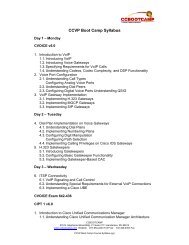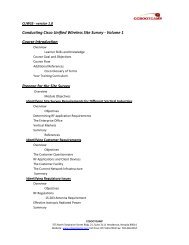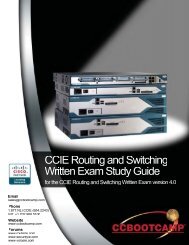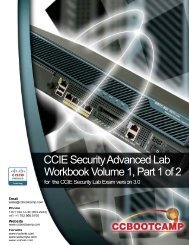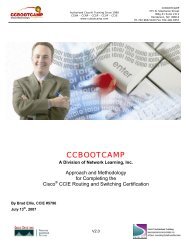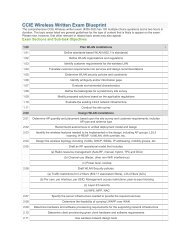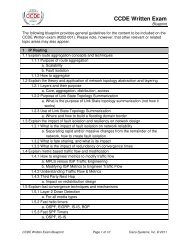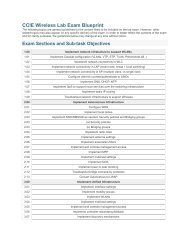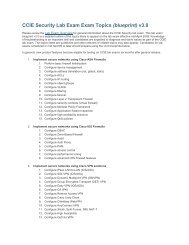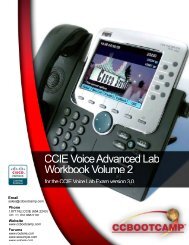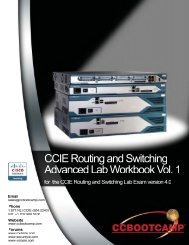Designing for Cisco Internetwork Solutions â Volume ... - CCBootcamp
Designing for Cisco Internetwork Solutions â Volume ... - CCBootcamp
Designing for Cisco Internetwork Solutions â Volume ... - CCBootcamp
You also want an ePaper? Increase the reach of your titles
YUMPU automatically turns print PDFs into web optimized ePapers that Google loves.
DESGN v2.1<strong>Designing</strong> <strong>for</strong> <strong>Cisco</strong> <strong>Internetwork</strong> <strong>Solutions</strong> – <strong>Volume</strong> 1Course IntroductionOverviewLearner Skills and KnowledgeCourse Goal and ObjectivesCourse FlowAdditional ReferencesYour Training CurriculumDesign Zone‐ <strong>Cisco</strong> Validated Designs<strong>Cisco</strong> Live & Networkers OnlineGeneral AdministrationNetwork Design Methodology OverviewModule ObjectivesUnderstanding the Network Architectures <strong>for</strong> the EnterpriseOverviewObjectivesBusiness Drivers <strong>for</strong> a New Network FrameworkBusiness ForcesTechnology‐Related ForcesIT Challenges<strong>Cisco</strong> Network Architectures <strong>for</strong> the EnterpriseBorderless Networks ArchitectureBorderless Networks Architecture ApproachCollaboration Architecture ApproachData Center/ Virtualization Architecture ApproachSummaryIdentifying Design RequirementsOverviewObjectivesUsing the PPDIOO Approach <strong>for</strong> NetworksBenefits of the Life‐Cycle ApproachUsing the PPDIOO Design MethodologyIdentifying Customer Design RequirementsIdentifying Network Applications and Network ServicesExample: Planned ApplicationsExample: Planned Intelligent Network ServicesCCBOOTCAMP375 North Stephanie Street Bldg. 21, Suite 2111 Henderson, Nevada 89014Website: www.ccbootcamp.com Toll Free: 877.654.2243 Fax: 702.446.0357
DESGN v2.1Defining Organizational ConstraintsExample: Defining Organizational GoalsDefining Organizational ConstraintsExample: Organizational ConstraintsDefining Technical GoalsExample: Technical GoalsAssessing Technical ConstraintsExample: Technical ConstraintsSummaryCharacterizing the Existing Network and SitesOverviewObjectivesCharacterizing the Network and SitesIdentifying Major Features of the NetworkSample Site Contact In<strong>for</strong>mationExample: Network DiagramAuditing the Existing NetworkExample: Network Audit In<strong>for</strong>mation SourcesExample: Network AuditUsing Tools <strong>for</strong> Auditing the NetworkRSPAN with VACLs <strong>for</strong> Granular Traffic AnalysisExample: Automatic In<strong>for</strong>mation Collection NetIQ Vivinet AssessorExample: Automatic In<strong>for</strong>mation Collection Using NetMRIExample: <strong>Cisco</strong> IOS NetFlow PrintoutExample: NBAR PrintoutAnalyzing Network Traffic and ApplicationsExample: Traffic AnalysisUsing Tools <strong>for</strong> Analyzing Network TrafficExample: AirMagnet VoFi GraphExample: SolarWinds OrionReviewing Network Traffic In<strong>for</strong>mationAnalyzing Network HealthExample: Equipment Summary ReportExample: Summary Report Problem StatementExample: Summary Report RecommendationsNetwork Characterization Time EstimatesSummaryUsing a Top‐Down Approach to Network DesignOverviewObjectivesIntroducing the Top‐Down Approach to Network DesignCCBOOTCAMP375 North Stephanie Street Bldg. 21, Suite 2111 Henderson, Nevada 89014Website: www.ccbootcamp.com Toll Free: 877.654.2243 Fax: 702.446.0357
DESGN v2.1Example: Top‐Down Voice DesignUsing Decision Tables in Network DesignExample: Selecting a Routing ProtocolAssessing the Scope of the Network Design ProjectExample: Assessing the Scope of the NetworkUsing Structured Design PrinciplesLogical StructurePhysical StructurePlanning an ImplementationExample: Planning an ImplementationExample: Summary Implementation PlanTesting Your DesignExample: Pilot NetworkDesign DocumentationSummaryModule SummaryReferencesModule Self‐CheckModule Self‐Check Answer KeyStructuring and Modularizing the NetworkOverviewModule Objectives<strong>Designing</strong> the Network HierarchyOverviewObjectivesIntroducing the Hierarchical Network ModelDescribing Access Layer FunctionalityCampus Access Layer ConnectivityDescribing Distribution Layer FunctionalityExample: Distribution Layer in the Traditional Campus NetworkExample: Distribution Layer in the Routed Campus NetworkDescribing Core Layer FunctionalityExample: Core Layer in the Traditional Campus NetworkExample: Core Layer in the Routed Campus NetworkExample: Collapsed Core in the Traditional Campus NetworkExample: Collapsed Core in the Routed Campus NetworkSummaryUsing a Modular Approach in Network DesignOverviewCCBOOTCAMP375 North Stephanie Street Bldg. 21, Suite 2111 Henderson, Nevada 89014Website: www.ccbootcamp.com Toll Free: 877.654.2243 Fax: 702.446.0357
DESGN v2.1ObjectivesDescribing <strong>Cisco</strong> Network Architectures <strong>for</strong> the Enterprise ModulesGuidelinesExample: Dividing the Network into AreasDescribing Enterprise Campus Infrastructure ModulesCampus Infrastructure ModuleDescribing the Enterprise Edge ModulesE‐Commerce ModuleInternet Connectivity ModuleRemote Access and VPN ModuleWAN and MAN and Site‐to‐Site VPN ModuleGuidelinesService Provider ModulesDescribing Enterprise Remote ModulesEnterprise Branch ModuleEnterprise Data Center ModuleEnterprise Teleworker ModuleSummarySupporting Services on Borderless NetworksOverviewObjectivesExplaining the Role of Borderless Network ServicesSecurity Infrastructure Services<strong>Designing</strong> Security to Protect Against External ThreatsExample: Voice Network SolutionMobility ConsiderationsApplication Per<strong>for</strong>mance ConsiderationsExample: <strong>Cisco</strong> ANS Can Resolve Application IssuesExample: <strong>Cisco</strong> ANS ComponentsHigh‐Availability Network ServicesDesign Consideration: Full‐Mesh vs. Partial‐Mesh RedundancyExample: Attachment Through a Redundant NICSummaryIdentifying Network Management Protocols and FeaturesOverviewObjectivesNetwork Management OverviewSNMP CharacteristicsSNMP Message TypesSNMP Version 2SNMP Version 3CCBOOTCAMP375 North Stephanie Street Bldg. 21, Suite 2111 Henderson, Nevada 89014Website: www.ccbootcamp.com Toll Free: 877.654.2243 Fax: 702.446.0357
DESGN v2.1Management In<strong>for</strong>mation Base (MIB) CharacteristicsExample: <strong>Cisco</strong> Router MIBExample: Variable RetrievalUsing RMONNetFlow CharacteristicsExample: NetFlow vs. RMON In<strong>for</strong>mation GatheringApplications Using NetFLow<strong>Cisco</strong> Discovery Protocol FeaturesSyslog FeaturesExample: Syslog MessagesSummaryModule SummaryReferencesModule Self‐CheckModule Self‐Check Answer Key<strong>Designing</strong> Basic Campus and Data Center NetworksOverviewModule ObjectivesDescribing Campus Design ConsiderationsOverviewObjectivesCampus Design FactorsNetwork Application Characteristics and ConsiderationsNetwork Requirements of ApplicationsEnvironmental Characteristics and ConsiderationsTransmission Media ConsiderationsCopperOptical FiberWirelessExample: Campus Transmission MediaExample: Transmission MediaInfrastructure Device Characteristics and ConsiderationsExample Network Service: QoS in LAN SwitchesQoS MechanismsTypical Switch Deployment in the Campus InfrastructureSummaryReferences<strong>Designing</strong> the Campus Infrastructure ModuleOverviewCCBOOTCAMP375 North Stephanie Street Bldg. 21, Suite 2111 Henderson, Nevada 89014Website: www.ccbootcamp.com Toll Free: 877.654.2243 Fax: 702.446.0357
DESGN v2.1ObjectivesDesign Considerations <strong>for</strong> the Campus NetworkDesign Considerations <strong>for</strong> the Building Access LayerBest Practices in the Building Access LayerManage VLANs and STPManage Trunks Between SwitchesManage Default PAgP SettingsConsider Implementing Routing in the Access LayerDesign Considerations <strong>for</strong> the Building Distribution LayerBest Practices in the Distribution LayerUse First‐Hop Redundancy ProtocolsDeploying Layer 3 Routing ProtocolsSupporting Layer 2 VLANs Spanning Multiple Access Layer SwitchesDesign Considerations <strong>for</strong> the Campus Core LayerSmall and Medium Campus Design OptionsSmall Campus Collapsed Core Network Design OptionMedium Campus Collapsed Core Network Design OptionEdge Distribution at the Campus CoreAlternative Designs <strong>for</strong> Edge Distribution SwitchesSummaryReferencesDescribing Enterprise Data Center ConsiderationsOverviewObjectivesDescribing the Enterprise Data Center Architectures<strong>Cisco</strong> Enterprise Data Center Architecture FrameworkExample: Data Center 3.0 Components LayoutEnterprise Data Center InfrastructureData Center Access LayerData Center Aggregation LayerData Center Core LayerSummaryReferencesDescribing Enterprise Network Virtualization ToolsOverviewObjectivesVirtualization OverviewChallengesWhat is Virtualization?Types of VirtualizationVirtualization TechnologiesCCBOOTCAMP375 North Stephanie Street Bldg. 21, Suite 2111 Henderson, Nevada 89014Website: www.ccbootcamp.com Toll Free: 877.654.2243 Fax: 702.446.0357
DESGN v2.1Network Virtualization Design ConsiderationsSummaryReferencesModule SummaryReferencesModule Self‐CheckModule Self‐Check Answer Key<strong>Designing</strong> Remote ConnectivityOverviewModule ObjectivesIdentifying WAN Technology ConsiderationsOverviewObjectivesReview of WAN FeaturesExample: WAN InterconnectionsComparison of WAN Transport TechnologiesTime‐Division MultiplexingISDN ConnectivityFrame RelayMultiprotocol Label SwitchingMetro EthernetDSL TechnologyCable TechnologyWireless TechnologySONET and SDH TechnologyDWDM TechnologyDark FiberWAN Transport Technology Pricing and Contract ConsiderationsWAN Design RequirementsResponse TimeThroughputExample: Response Time and Link UtilizationReliabilityQoS Considerations <strong>for</strong> Bandwidth ConstraintsTraffic Shaping and PolicingSummary<strong>Designing</strong> the Enterprise WANOverviewObjectivesCCBOOTCAMP375 North Stephanie Street Bldg. 21, Suite 2111 Henderson, Nevada 89014Website: www.ccbootcamp.com Toll Free: 877.654.2243 Fax: 702.446.0357
DESGN v2.1Traditional WAN DesignsRemote‐Access Network DesignVPN DesignEnterprise vs. Service Provider Managed VPNEnterprise Managed VPN: IPsecIPsec Direct Encapsulation<strong>Cisco</strong> Easy VPNLayer 3 TunnelingIPsec VTI DesignL2TPv3 DesignService Provider Managed VPN: Metro EthernetVPLS DesignMPLS DesignMPLS Layer 3 VPN DesignWAN Backup DesignWAN Backup Design <strong>for</strong> the InternetSelecting the Enterprise WAN Architecture<strong>Cisco</strong> Enterprise MAN and WAN ArchitectureSelecting Enterprise WAN ComponentsHardware SelectionHardware Selection: <strong>Cisco</strong> ISR G2Software SelectionSummary<strong>Designing</strong> the Enterprise BranchOverviewObjectivesEnterprise Branch ArchitectureEnterprise Branch DesignNew Features on the ISR G2 RoutersSmall Branch Office DesignMedium Branch Office DesignLarge Branch Office DesignEnterprise Teleworker (<strong>Cisco</strong> Virtual Office Solution) DesignNew ISRs <strong>for</strong> Small Offices and TeleworkersSummaryModule SummaryReferencesModule Self‐CheckModule Self‐Check Answer KeyCCBOOTCAMP375 North Stephanie Street Bldg. 21, Suite 2111 Henderson, Nevada 89014Website: www.ccbootcamp.com Toll Free: 877.654.2243 Fax: 702.446.0357
DESGN v2.1<strong>Designing</strong> <strong>for</strong> <strong>Cisco</strong> <strong>Internetwork</strong> <strong>Solutions</strong> – <strong>Volume</strong> 2<strong>Designing</strong> IP Addressing and Selecting Routing ProtocolsOverviewObjectives<strong>Designing</strong> IPv4 AddressingOverviewObjectivesIPv4 AddressingPrivate and Public Addressing GuidelinesDeveloping an Addressing PlanPlanning the IP Addressing HierarchyDesign Consideration: Route Summarization GroupsExample: Address Blocks by LocationExample: Hierarchical IP Addressing PlanRecommended Practices <strong>for</strong> Name ResolutionExample: Locating DHCO and DNS Servers in the NetworkIP Address Space Planning RoadmapSummary<strong>Designing</strong> IPv6 AddressingOverviewObjectivesIPv6 AddressingExample: IPv6 AddressBenefits <strong>for</strong> IPv6 AddressingIPv6 Address TypesIPv6 Address Assignment StrategiesIdentifying IPv6 Name ResolutionMaking the Transition from IPv4 to IPv6Strategies <strong>for</strong> IPv6 DeploymentDual‐Stack ModelHybrid ModelService Block ModelSummaryReviewing Enterprise Routing ProtocolsOverviewObjectivesReviewing Routing Protocol FundamentalsDifferentiating Between Distance Vector and Link‐State Routing ProtocolsCCBOOTCAMP375 North Stephanie Street Bldg. 21, Suite 2111 Henderson, Nevada 89014Website: www.ccbootcamp.com Toll Free: 877.654.2243 Fax: 702.446.0357
DESGN v2.1Differentiating Between Interior and Exterior Routing ProtocolsExample: Interior vs. Exterior Routing ProtocolsRouting Protocol ConvergenceRouting Protocols <strong>for</strong> the EnterpriseEnhanced IGRPOpen Shortest Path FirstBorder Gateway ProtocolIPv6 RoutingSelecting an Enterprise Routing ProtocolSummary<strong>Designing</strong> a Routing Protocol DeploymentOverviewObjectivesApplying Routing Protocols to a Hierarchical Network StructureRouting in the Campus CoreRouting in the Building Distribution LayerRouting in the Enterprise Edge AreaRouting in the Remote‐Access and VPN and Internet Connectivity ModulesRoute RedistributionRoute Redistribution PlanningRoute FilteringRoute SummarizationRecommended Practice: Summarize at the Distribution LayerRecommended Practice: Passive Interfaces <strong>for</strong> IGP at the Access LayerIPv6 Route SummarizationSummaryModule SummaryReferencesModule Self‐CheckModule Self‐Check Answer KeyEvaluating Security <strong>Solutions</strong> <strong>for</strong> the NetworkOverviewModule ObjectivesDefining Network SecurityOverviewObjectivesNetwork Security BackgroundExamples: Security LegislationExample Threat: Reconnaissance AttacksCCBOOTCAMP375 North Stephanie Street Bldg. 21, Suite 2111 Henderson, Nevada 89014Website: www.ccbootcamp.com Toll Free: 877.654.2243 Fax: 702.446.0357
DESGN v2.1Implementing CAC with RSVPVoice Traffic Engineering OverviewExample: Erlang B TableSummaryModule SummaryReferencesModule Self‐CheckModule Self‐Check Answer KeyIdentifying Design Considerations <strong>for</strong> Basic Wireless NetworkingOverviewModule Objectives<strong>Cisco</strong> Unified Wireless Network ReviewOverviewObjectives<strong>Cisco</strong> Unified Wireless Network Architecture<strong>Cisco</strong> Unified Wireless Network ElementsCAPWAP and LWAPP FundamentalsExample: Layer 3 CAPWAP ArchitectureSplit Media Access ControlLocal Media Access ControlAccess Point ModesWireless InfrastructureWireless AuthenticationOverview of WLAN ControllersExample: WLANS, Interfaces, and PortsAccess Point Support and ScalingAccess Point Scalability ConsiderationsExample: Multiple AP Manager InterfacesExample: LAG with a Single AP Manager InterfaceSummaryWireless Network Controller TechnologyOverviewObjectivesLightweight Access Point Connectivity to a WLCWLC SelectionLightweight Access Point OperationsMobility in the <strong>Cisco</strong> Unified Wireless NetworkIntracontroller RoamingIntercontroller Roaming‐Layer 2CCBOOTCAMP375 North Stephanie Street Bldg. 21, Suite 2111 Henderson, Nevada 89014Website: www.ccbootcamp.com Toll Free: 877.654.2243 Fax: 702.446.0357
DESGN v2.1Intercontroller Roaming‐Layer 3Mobility GroupsExample: Mobility Group RequirementsRecommended Practices <strong>for</strong> Supporting RoamingController Redundancy DesignDeterministic Controller RedundancyExample: Deterministic Controller RedundancyDynamic Controller RedundancyExample: Dynamic Controller RedundancyN + 1 Redundancy DesignN + N Redundancy DesignN + N + 1 Redundancy DesignRadio Resource Management and RF GroupsAccess Point Self‐HealingSummary<strong>Designing</strong> Wireless Networks Using ControllersOverviewObjectivesRF Site SurveyRF Site Survey ProcessDesign Considerations <strong>for</strong> Campus Wireless NetworksExample: CAPWAP Access Point Feature SummaryController Placement DesignExample: Centralized WLC PlacementExample: Distributed WLC DesignCampus <strong>Cisco</strong> Wireless LAN Controller OptionsDesign Considerations <strong>for</strong> Branch Wireless NetworksHybrid REAPBranch Office <strong>Cisco</strong> Wireless LAN Controller OptionsDesign Considerations <strong>for</strong> Guest Services in Wireless NetworksDesign Considerations <strong>for</strong> Outdoor Wireless NetworksWireless Mesh ComponentsExample: MAP‐to‐RAP ConnectivityMesh Design RecommendationsSummaryModule SummaryReferencesModule Self‐CheckModule Self‐Check Answer KeyCCBOOTCAMP375 North Stephanie Street Bldg. 21, Suite 2111 Henderson, Nevada 89014Website: www.ccbootcamp.com Toll Free: 877.654.2243 Fax: 702.446.0357
DESGN v2.1<strong>Designing</strong> <strong>for</strong> <strong>Cisco</strong> <strong>Internetwork</strong> <strong>Solutions</strong>Lab GuideOverviewThis guide presents the instructions and other in<strong>for</strong>mation concerning the lab activities <strong>for</strong> thiscourse. You can find the solutions in the Lab Activity Answer Key.OutlineThis guide includes these activities:• Case Study 1‐1: ACMC Hospital Network Upgrade In<strong>for</strong>mation• Case Study 2‐1: ACMC Hospital Network Structure and Modularity• Case Study 3‐1: ACMC Hospital Network Campus Design• Case Study 4‐1: ACMC Hospital Network WAN Design• Case Study 5‐1: ACMC Hospital Network IP Addressing and Routing Protocol Design• Case study 6‐1: ACMC Hospital Network Security Design• Case Study 7‐1: ACMC Hospital Network Voice Transport Considerations• Case Study 8‐1: ACMC Hospital Network Wireless Networking Considerations• Case Study 8‐2: Connecting More Hospitals to the ACMC Hospital Network• Answer Key• Course WorksheetsCCBOOTCAMP375 North Stephanie Street Bldg. 21, Suite 2111 Henderson, Nevada 89014Website: www.ccbootcamp.com Toll Free: 877.654.2243 Fax: 702.446.0357



